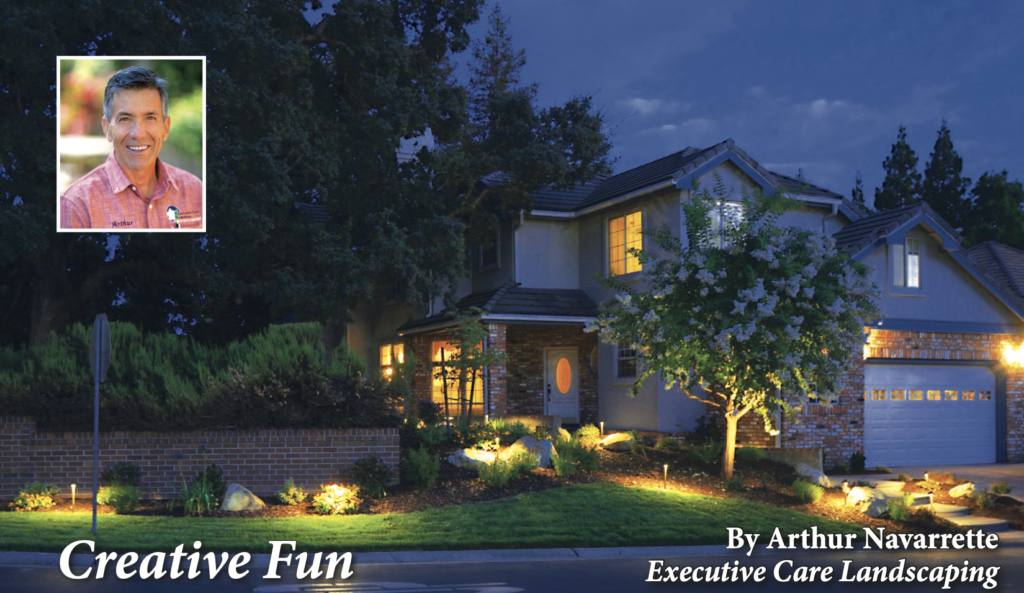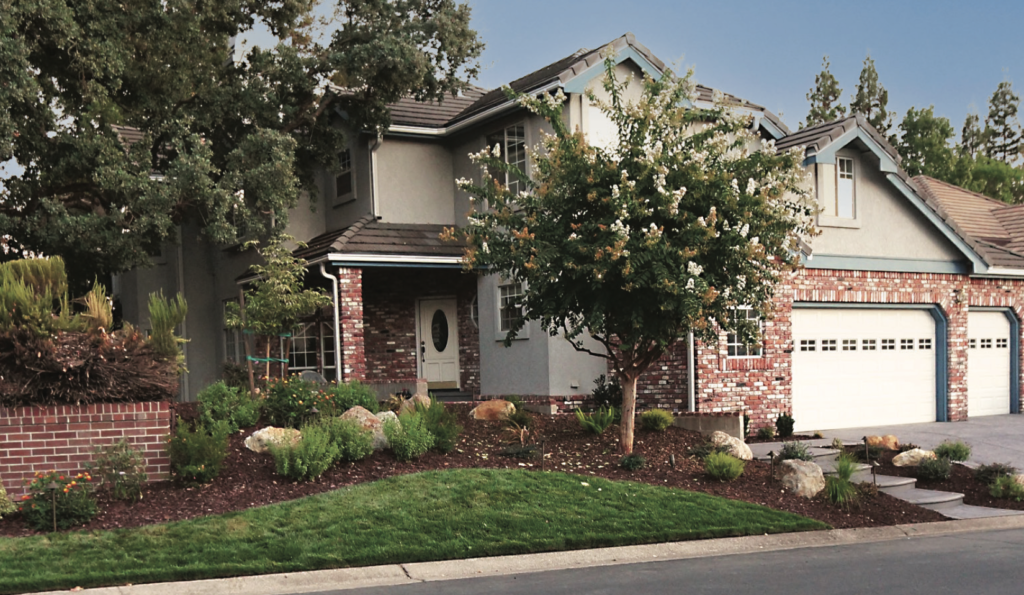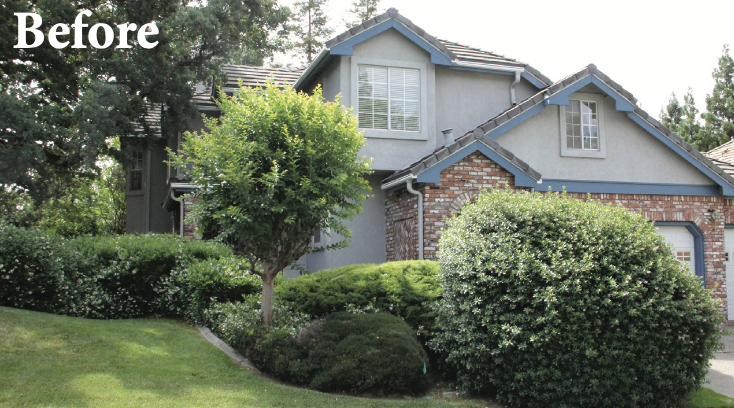


Welcome to our September edition. I appreciate the readership we experience,
and the business from those who trust us to do the work. Recently, I started doing
jobs for two clients that have been reading our articles for years, and it’s great. It
is so easy to work with them, because I have gained their trust. It is easy to tell
the difference between those who find us on the internet, versus those who have
read our articles. We appreciate them both, but the trust and the confidence are
so much more established with those who have been reading our articles.
This month’s landscape is from clients that have been reading our articles as well.
We completed their landscape in June, so it is still a relatively new landscape.
All
our jobs bring artistic change and new plants. However, there are jobs where the
change is going to be such a difference, that until we get the plants in, it is hard
for the client to envision it. This job was one of those jobs. It included a new
driveway and walkway, both existing in aggregate form, (gravel finish, changing
over to stamped and dyed) as well as new steps. When there is that much
concrete, I bring in my concrete friend Raymond to do the work. We broke out
the concrete and removed the concrete with our tractor. Once cleared, I painted
out the new design. I prefer to use marker paint and design in the client’s yard. I
feel it is more real, and the sense of scale is easier to envision. For this job, I
needed the walkway to the front door to be narrower. At 4 ½ feet, it was too
wide. I needed more space to add decorative plants. For the steps, I needed
Raymond’s help. I could paint out the direction the steps were to go in, but he
had to determine the number of steps and their height. The combination of both
our skills, as well as our men’s skill, gave our client’s Mark and Sharon a very nice
job.
Sometimes when two contractors are on a job, it is a bit of a juggling act
determining the order of the work. However, with this job, the work could be split
in half. To the left of the block wall, my crew could work, and to the right which
included the driveway, walk and steps, Raymond’s crew could work. When it
came time to pour the concrete, we had only a few days left to finish the left side.
This gave the concrete the days it needed to harden. Once finished, we started
the other side.
The goal with all landscapes is to create a design that is colorful, low maintenance
and unique. I am dealing with a client right now that says she is able to drive
through a neighborhood and tell her husband which jobs belong to Executive
Care. That is such a nice compliment. We do follow a procedure, and each and
every job is done in this manner. The difference will be found in the plants used,
which has to do with the sunlight. Sunlight is a big deal in my world, and greatly
influences the plant selection. All day, or partial sun determine the choice of
plants. This goes for all day, or partial shade as well. A sun landscape is a
landscape with 7 hours of sun, with the majority of the sun being in the
afternoon. It could have 4 hours of shade in the morning, but I would still classify
it as a full sun landscape if the sun was afternoon sun. A shade landscape is just
the opposite. Instead of sun in the afternoon, it has shade. The hardest landscape
is the one that has filtered shade, or shade all day long with late afternoon to
early evening full sun. There are very few plants that can handle that
environment. Fortunately, this situation is rare.
There are other factors which come into play in selecting plants for tough areas.
For example, the season we are in effects plant selection. Do the plants have
enough time to acclimate to their new environment before summer heat or
winter cold? Where are the growing grounds of the plants, or the wholesale
nurseries that grow them? Green Acres is retail, and they are not the growers.
The plants at Green Acres come from three main locations: here in the
Sacramento Valley, the bay area and Oregon. If the plants for the job are grown
here in the valley, there is no concern. They come acclimated. If they are grown in
the other two regions, then depending upon the season and the temperatures, I
may choose to use them or not. If I need those specific plants, because of size or
color, then it’s a bit of a gamble. If we get hot or cold temperatures before they
acclimate, there is a chance that some foliage may burn. However, once the
extreme temperatures are over, they will grow out.
Now back to Mark and Sharon’s job. They did not give me many instructions other
than they wanted a colorful landscape. In viewing their landscape during our
initial visit, I saw problems with the lawn (see the before picture). Lawns on the
slope are difficult to keep moist, especially when the same sprinkler system
waters all the slope and the level portion. Slopes need to be separated from level
sections of lawn. They require short intervals of water- 4 to 5 minutes, 2 to 3
times per watering, and they need to be aerated at least once a year if not twice.
Given this concern, and the client’s willingness to lessen the lawn, I knew what we
were going to do. As you can see in the picture, we kept the level part of the lawn,
and just a portion of the slope. To make the rest of the slope more plant friendly,
we brought in larger Sierra boulders and created “planter scenes” by mounding
extra soil around them.
Planting the sidewalk area was a bit challenging. It was difficult to determine the
sunlight. When I can’t gauge the sunlight because of a tree or the house’s roof
line obstructing the sun, I ask the client to take pictures starting from 12 pm every
2 hours until 7, which helps a lot.
Finally, I would like to comment on landscaping with the current water shortage
concern. The more landscapes that can be converted over to drip irrigation, the
better at conserving water we become. For example, drip emitters are .5, 1 and 2
gallons per hour, and the most water conserving nozzle for lawn is .72 (MP’s half
pattern 12’) gallons per minute. This is much better than the original nozzles that
were 1.62(12H) gallons per minute. Therefore, my recommendation would be to
reduce your lawn to what fits your lifestyle, and update your nozzles. The extra
space (assuming you reduce the lawn) can be used for more plants, a fire pit,
bocci court, or outdoor patio area. You would be saving water while enjoying your
yard. I hope you enjoy this yard/article as much as I enjoyed sharing it with you.
Until next time – Good Gardening, Arthur
